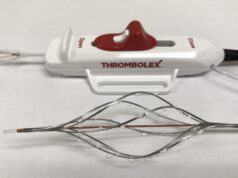
The pitfalls of large administrative databases came to the fore during the presentation of a propensity-match scoring analysis demonstrating that percutaneous mechanical thrombectomy (MT) was superior to catheter-directed thrombolysis (CDT) in patients diagnosed with acute pulmonary embolism (PE). Junji Taukagoshi, a vascular surgery resident at the University of Texas Medical Branch (UTMB) in Galveston, USA, presented the results from the retrospective analysis of patients drawn from the multi-institutional TriNetX network during the 2024 Southern Association for Vascular Surgery (SAVS) annual meeting (Jan. 24–27) in Scottsdale, USA.
Taukagoshi and colleagues—including senior author Mitchell Cox, the vascular surgery program director at UTMB—showed that MT was associated with fewer 30-day perioperative complications, improved long-term pulmonary hypertension and right heart failure, and significantly fewer emergency room (ER) visits.
They performed the 1:1 propensity-match analysis with around 1,100 in each group who underwent the respective interventions within three days of a PE diagnosis from January 2017 to August 2023.
But the question of whether large administrative databases like TriNetX to produce the granularity of data can enable robust enough analysis quickly emerged when the study came under post-presentation scrutiny, with one questioner suggesting the research team perform sensitivity analysis to “potentially tease out these patients a little bit more precisely to make sure you don’t have a melting pot of individuals.”
Taukagoshi and Cox both acknowledged this limitation, with the latter describing both its benefits—large size, breadth and ease of use—along with the chief drawback that means “you can only get certain data from it.”
Taukagoshi detailed 30-day results show comparable mortality and number of blood transfusions. “However, MT was clearly superior when it comes to gastrointestinal bleed and intracranial hemorrhage. it is interesting that it was also superior with both lower rates of myocardial infarction and immediate post-procedural pulmonary hypertension. So, it looks like MT is the clear winner in the acute phase.”
Long term, MT continued to have better outcomes out to five years, Taukagoshi continued. “While mortality is not that much different, the incidence of chronic pulmonary hypertension and right heart failure are much improved in patients who had MT. They also had significantly fewer ER visits.”
Commenting further, he said 30-day data clearly showed MT as associated with “significantly fewer bleeding complications compared to CDT, which can be explained by thrombolytics,” alongside the lower incidence of MI and immediate postoperative pulmonary hypertension.
“Why is that?” he asked.
“We would speculate that more rapid clot clearance with MT might result in less myocardial strain and more rapid improvement in pulmonary hemodynamics.”
At five years, MT was also shown to be better, Taukagoshi added. “However, the overall incidence of chronic pulmonary hypertension is certainly higher than in previous studies. Clearly, our patient cohort had a high percentage of very significant high-risk PE events.”
So, is MT truly better? Taukagoshi asked, as he pointed to the limitations inherent in large databases. He further revealed that such data had persuaded his institution to shift away from thrombolysis toward MT in the majority of cases where interventions are required for massive or submassive PE.
“In the future, we would like to see if these results can be replicated with other large multi-institutional series or large datasets.”
Discussion points to lack of PE risk stratification information

Designated discussant Jean Panneton, a professor of surgery at Eastern Virginia Medical School in Norfolk, USA, led queries of the paper. He pointed to a lack of PE risk stratification information. “How do you believe that this may have impacted your results—[with] a propensity match that only matched for regular comorbidities, but nothing specific to the actual PE?”
In light of the administrative database source of the data and attendant Current Procedural Terminology (CPT) codes, Panneton questioned whether it was possible to know whether all of the interventions for suction thrombectomy or CDT were indeed “actually done for PE.”
“Could they have been possibly done for ischemic legs or for the 43% of patients with acute deep vein thrombosis [DVT] in that database?”
Jason Chin, a vascular surgeon at MedStar Health in Baltimore, USA, pointed out the different CDT regimens available and how that might have impacted results.
“It doesn’t seem like this database can parse that out,” he said. “I’m not sure if there is a code for ultrasound-assisted thrombolysis versus no-ultrasound assisted thrombolysis.”









